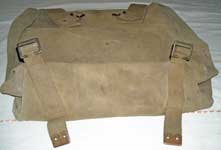W.E. Patt. '08 Packs
Introduced with the W.E. Patt. '08 by List of Changes entry L. of C. 14288, dated 31st January 1908, the Pack, was designed to carry the soldier's Greatcoat; Cap, comforter; Holdall; Housewife; Mess tin and cover; Socks, Soap; and Towel. The Pack underwent only a few changes throughout its service life.
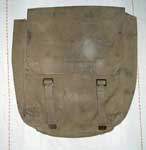
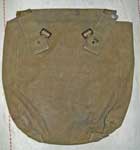 The W.E. Patt. '08 Pack, first issue, is a rectangular webbing bag approximately 15-inches tall, 13-inches wide, and 4-inches deep. The flap is closed by two 1-inch straps that attach to two 1-inch chapes and Twigg buckles sewn to the front of the Pack. At the rear, there are two 2-inch web tabs angled outwards at the top, along with two short 1-inch chapes and Twigg buckles angled in. At the bottom are two 1-inch web loops. The straps and tabs are finished with plain brass tips. In use, the Pack is supported by the two 1-inch Straps, supporting. These are buckled to the angle straps at the rear of the Cartridge carriers, pass through the loops at the base of the Pack, and cross over the its face to attache to the angled 1-inch buckles at the Pack's top rear. These straps form a "figure-8" cradle that balances the weight of the pack evenly, so that, in use, Web Equipment, Pattern 1908, can be worn fully balanced, even with the Belt unfastened in front. The 2-inch angled straps buckle to the Braces with running Twigg buckles. These are required only to keep the top of the Pack from falling backwards. It is important that the buckles on the Braces be adjusted so that these tabs do not take the weight of the Pack, which should be carried by the Supporting straps alone. This example is maker marked "M.W. & S., Ltd." and dated 1909.
The W.E. Patt. '08 Pack, first issue, is a rectangular webbing bag approximately 15-inches tall, 13-inches wide, and 4-inches deep. The flap is closed by two 1-inch straps that attach to two 1-inch chapes and Twigg buckles sewn to the front of the Pack. At the rear, there are two 2-inch web tabs angled outwards at the top, along with two short 1-inch chapes and Twigg buckles angled in. At the bottom are two 1-inch web loops. The straps and tabs are finished with plain brass tips. In use, the Pack is supported by the two 1-inch Straps, supporting. These are buckled to the angle straps at the rear of the Cartridge carriers, pass through the loops at the base of the Pack, and cross over the its face to attache to the angled 1-inch buckles at the Pack's top rear. These straps form a "figure-8" cradle that balances the weight of the pack evenly, so that, in use, Web Equipment, Pattern 1908, can be worn fully balanced, even with the Belt unfastened in front. The 2-inch angled straps buckle to the Braces with running Twigg buckles. These are required only to keep the top of the Pack from falling backwards. It is important that the buckles on the Braces be adjusted so that these tabs do not take the weight of the Pack, which should be carried by the Supporting straps alone. This example is maker marked "M.W. & S., Ltd." and dated 1909.
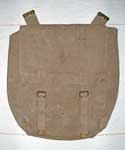
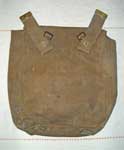 The W.E. Patt. '08 Pack, second issue, was effectively introduced by List of Changes entry L. of C. 15048, dated 22nd November 1909, but not actually appearing in the List until 1st June 1910. This L. of C. entry was a "catch-all" of minor fixes to W.E. Patt. '08, based on its first year in service. Three of these changes affected the Pack. First, the brass tips of all straps and tabs were changed from plain to eyeletted. Second,the gusset was increased from 4 to 4 1/2-inches, deepening the Pack slightly. Third, the angled tabs and chapes at the top rear of the Pack were raised slightly. The L. of C. entry also stated that the 2-inch rear tabs were increased in length by 1-inch and were made of thicker web. This may have been recognition of a design change already in effect. The 2-inch tabs on the 1909 dated first issue Pack on this page are identical to the ones on the second issue Pack shown here. This second issue example is maker marked "M.E. Co." and dated 1915.
The W.E. Patt. '08 Pack, second issue, was effectively introduced by List of Changes entry L. of C. 15048, dated 22nd November 1909, but not actually appearing in the List until 1st June 1910. This L. of C. entry was a "catch-all" of minor fixes to W.E. Patt. '08, based on its first year in service. Three of these changes affected the Pack. First, the brass tips of all straps and tabs were changed from plain to eyeletted. Second,the gusset was increased from 4 to 4 1/2-inches, deepening the Pack slightly. Third, the angled tabs and chapes at the top rear of the Pack were raised slightly. The L. of C. entry also stated that the 2-inch rear tabs were increased in length by 1-inch and were made of thicker web. This may have been recognition of a design change already in effect. The 2-inch tabs on the 1909 dated first issue Pack on this page are identical to the ones on the second issue Pack shown here. This second issue example is maker marked "M.E. Co." and dated 1915.
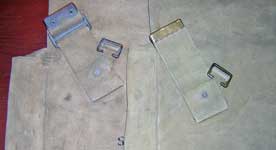 This detail shows the angled tabs and chapes at the top rear of the second issue (left) and first issue (right) Packs. On the second issue Pack, the angled tabs and chapes have been raised about 1 1/2-inches compared to their location on the first issue. This change was made because of the change to the Braces introduced by L. of C. .The first issue Braces had a wider area in the center, designed to act as a bearing area across the shoulders. Second issue Braces were made from a uniform strap of webbing 2-inches wide. In order for the Pack to ride at the correct height (the bottom of the Pack should be at the same elevation as the bottom of the Belt), the angled tabs and chapes had to be low enough to allow the buckle on the Brace to fit below the widened section. With the second issue uniform width Brace, this buckle could be higher up, where it could be accessed more easily. The angled tabs and chapes were moved to suit.
This detail shows the angled tabs and chapes at the top rear of the second issue (left) and first issue (right) Packs. On the second issue Pack, the angled tabs and chapes have been raised about 1 1/2-inches compared to their location on the first issue. This change was made because of the change to the Braces introduced by L. of C. .The first issue Braces had a wider area in the center, designed to act as a bearing area across the shoulders. Second issue Braces were made from a uniform strap of webbing 2-inches wide. In order for the Pack to ride at the correct height (the bottom of the Pack should be at the same elevation as the bottom of the Belt), the angled tabs and chapes had to be low enough to allow the buckle on the Brace to fit below the widened section. With the second issue uniform width Brace, this buckle could be higher up, where it could be accessed more easily. The angled tabs and chapes were moved to suit.
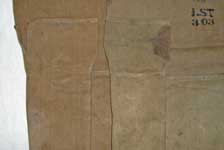 This detail shows the widened gusset of the second issue Pack. The second issue Pack (left) is 4 1/2-inches deep, whilst the first issue (right) is only 4-inches deep.
This detail shows the widened gusset of the second issue Pack. The second issue Pack (left) is 4 1/2-inches deep, whilst the first issue (right) is only 4-inches deep.
Pack, First/second issue hybrid

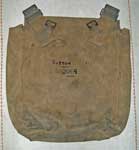 With even the most stringent quality control the occasional oddball manages to creep in. At first glance, this is a perfectly normal second issue Patt. '08 Pack, but closer examination reveals that its side gusset is only 4-inches wide. The explanation that seems most likely to me is that the bag portion was made to the first issue specifications, but for some reason the pack was not completed and issued until after the new specification was released. Whatever the case, Mills were unlikely to discard what was, after all, a perfectly usable item. A curiosity only, this pack is maker marked "M.E. Co." and dated 1911.
With even the most stringent quality control the occasional oddball manages to creep in. At first glance, this is a perfectly normal second issue Patt. '08 Pack, but closer examination reveals that its side gusset is only 4-inches wide. The explanation that seems most likely to me is that the bag portion was made to the first issue specifications, but for some reason the pack was not completed and issued until after the new specification was released. Whatever the case, Mills were unlikely to discard what was, after all, a perfectly usable item. A curiosity only, this pack is maker marked "M.E. Co." and dated 1911.
Pack, Second issue (Economy) with modifications
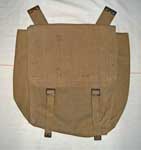
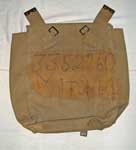 Just as with Waist belts and Cartridge carriers, there was a slightly simplified "economy" version of the Pack. This example is a standard second issue Patt. '08 Pack, except that the strengthening rivets have been omitted from the 2-inch rear tabs - the tabs are simply sewn in place. I have not found any official documentation for this change, but Packs dated 1917-18 with this modification are not uncommon. This Pack is maker marked "M.E. Co." and dated 1918.
Just as with Waist belts and Cartridge carriers, there was a slightly simplified "economy" version of the Pack. This example is a standard second issue Patt. '08 Pack, except that the strengthening rivets have been omitted from the 2-inch rear tabs - the tabs are simply sewn in place. I have not found any official documentation for this change, but Packs dated 1917-18 with this modification are not uncommon. This Pack is maker marked "M.E. Co." and dated 1918.
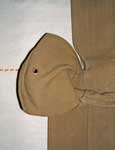 This particular Pack has another modification as well. List of Changes entry L. of C. No. 24993,dated 15th May 1922, modified the side flaps of the pack to add an eyeletted hole in each. This allowed the soldier to use a piece of twine to tie the inside flaps in place. This L. of C. entry was both a pattern for future production and a direction for modifying existing Packs in service. This 1918 example has been modified to match the L. of C..
This particular Pack has another modification as well. List of Changes entry L. of C. No. 24993,dated 15th May 1922, modified the side flaps of the pack to add an eyeletted hole in each. This allowed the soldier to use a piece of twine to tie the inside flaps in place. This L. of C. entry was both a pattern for future production and a direction for modifying existing Packs in service. This 1918 example has been modified to match the L. of C..
Pack, Canadian Web Equipment, Pattern 1913
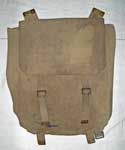
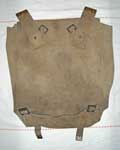 The Canadian Web Equipment, Pattern 1913, was introduced with Canadian List of Changes entry No. 1203 (not dated but 1913). It is an early variation of the Mills Back Adjustment Equipment, and as such is not really a close relative of W.E. Patt. '08. The W.E. Patt. '13 Pack, though, is almost identical to the Patt. '08 Pack. The only difference between the two is that, in Patt. '13, the two small loops at the bottom rear of the Pack are replaced with short buckled straps. The buckles on these straps attach to the diagonal straps at the rear of the Cartridge carriers, and the free ends buckle to the Supporting straps (identical to the Patt. '08 ones), which are then crossed over the face of the Pack to attach in the same way as Patt. '08 Supporting straps. This example is maker marked "M.E. Co." and dated 1913.
The Canadian Web Equipment, Pattern 1913, was introduced with Canadian List of Changes entry No. 1203 (not dated but 1913). It is an early variation of the Mills Back Adjustment Equipment, and as such is not really a close relative of W.E. Patt. '08. The W.E. Patt. '13 Pack, though, is almost identical to the Patt. '08 Pack. The only difference between the two is that, in Patt. '13, the two small loops at the bottom rear of the Pack are replaced with short buckled straps. The buckles on these straps attach to the diagonal straps at the rear of the Cartridge carriers, and the free ends buckle to the Supporting straps (identical to the Patt. '08 ones), which are then crossed over the face of the Pack to attach in the same way as Patt. '08 Supporting straps. This example is maker marked "M.E. Co." and dated 1913.
This detail shows the bottom of the Pack, W.E., Patt. '13. Note the short buckled straps that replace the web loops of the Pack, W.E. Patt. '08.
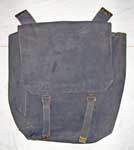
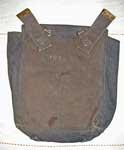
 In the Mills Golden Jubilee booklet, The Development of the Mills Woven Cartridge Belt, 1877-1956, Albert Lethern states that in 1922 the Irish Free State placed an order with the Mills Equipment Company for a "large" order of Web Equipment, Pattern 1908. The equipment was supplied in a special green colour. The equipment as supplied was a complete set of Pattern 1908 Infantry Equipment, omitting the Entrenching tool head carrier and Helve holder. Also, the Frog did not have a strap for the Helve holder. I have seen a few pieces of this equipment, including the Pack shown here, but it has all been dyed or painted black in service. Other than the colour, this is a typical Patt. '08 Pack. The markings included the usual "M.E. Co." maker's mark and a 1923 production date, but the Pack also carries the "Fianna Fail" FF surrounded by a sunburst mark of the Irish Army.
In the Mills Golden Jubilee booklet, The Development of the Mills Woven Cartridge Belt, 1877-1956, Albert Lethern states that in 1922 the Irish Free State placed an order with the Mills Equipment Company for a "large" order of Web Equipment, Pattern 1908. The equipment was supplied in a special green colour. The equipment as supplied was a complete set of Pattern 1908 Infantry Equipment, omitting the Entrenching tool head carrier and Helve holder. Also, the Frog did not have a strap for the Helve holder. I have seen a few pieces of this equipment, including the Pack shown here, but it has all been dyed or painted black in service. Other than the colour, this is a typical Patt. '08 Pack. The markings included the usual "M.E. Co." maker's mark and a 1923 production date, but the Pack also carries the "Fianna Fail" FF surrounded by a sunburst mark of the Irish Army.
"Wearing the Pack Rucksack Fashion"
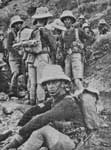 As directed by the Fitting Instructions, the Patt. ’08 Pack was attached to the Braces and diagonal straps of the Cartridge carriers. Access the Pack’s contents meant un-fastening the Straps, supporting pack, which was a bit tedious. An alternative method of carriage was un-officially evolved by soldiers. This had yet to be seen in any Great War photograph, but one shot had been noted on British troops on the North-West Frontier, in India, in 1936. The photo at left is from The Northwest Frontier. British India and Afghanistan. A Pictorial History 1839-1947, by Michael Barthorp (Blandford Press Ltd., 1982). KW is therefore delighted to now be able to add additional text, as we have been sent the superb photograph at lower right – from the Great War - showing a soldier of the 244th (Kitchener’s Own) Infantry Bn., Canadian Expeditionary Force. The 244th were recruited in Montreal and the surrounding area.
As directed by the Fitting Instructions, the Patt. ’08 Pack was attached to the Braces and diagonal straps of the Cartridge carriers. Access the Pack’s contents meant un-fastening the Straps, supporting pack, which was a bit tedious. An alternative method of carriage was un-officially evolved by soldiers. This had yet to be seen in any Great War photograph, but one shot had been noted on British troops on the North-West Frontier, in India, in 1936. The photo at left is from The Northwest Frontier. British India and Afghanistan. A Pictorial History 1839-1947, by Michael Barthorp (Blandford Press Ltd., 1982). KW is therefore delighted to now be able to add additional text, as we have been sent the superb photograph at lower right – from the Great War - showing a soldier of the 244th (Kitchener’s Own) Infantry Bn., Canadian Expeditionary Force. The 244th were recruited in Montreal and the surrounding area.
 The 2-inch sliding buckles were brought to the wearer’s upper chest, from behind the shoulders. The Straps, supporting pack, were passed through the web loops on the base of the Pack, doubled through one side of the 1-inch buckle and then to the upper 1-inch buckles between the 2-inch Brace tabs. The resulting “shoulder straps” allowed the Pack to be worn in “rucksack fashion”, the Straps being hooked under the outer “horn” of the 2-inch buckles, to stop them cutting into the armpits.
The 2-inch sliding buckles were brought to the wearer’s upper chest, from behind the shoulders. The Straps, supporting pack, were passed through the web loops on the base of the Pack, doubled through one side of the 1-inch buckle and then to the upper 1-inch buckles between the 2-inch Brace tabs. The resulting “shoulder straps” allowed the Pack to be worn in “rucksack fashion”, the Straps being hooked under the outer “horn” of the 2-inch buckles, to stop them cutting into the armpits.
The use of the Supporting straps in this manner was later regularised in the Fitting Instructions for Patt. ’37 W.E., being illustrated in Plate 21. Photo from the collection of Patrick LeBrun.
